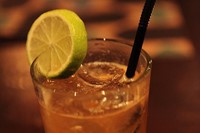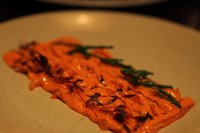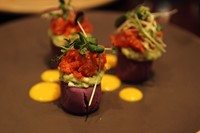Peruvian cuisine is a culinary trend in full swing, and this last year has seen several new openings in central London, including Lima in Fitzrovia, Ceviche in Soho, and Coya in Mayfair...
Peruvian cuisine is a culinary trend in full swing. Quinoa, ceviche, and Pisco sours have become desirable commodities, while new restaurants inspired by Andean ingredients regularly launch to great fanfare. This last year has seen several new openings in central London, including Lima in Fitzrovia, Ceviche in Soho, and Coya in Mayfair.
One of the young chefs at the forefront of Peruvian cuisine is Lima’s Virgilio Martinez, who tells us that things are moving quickly on his country’s culinary scene, in part due to the new flavours being discovered in the Amazon and the Andes. And though he spends much of his time at Central, his much-lauded restaurant in Peru, Martinez regularly visits London to share his latest finds. “We want to be innovative,” he says. “Lima is a city that is really evolving, and what we do here in London is show what’s happening in Lima and what people are eating there now.”
For Martinez, authenticity is about maintaining a connection to the land and to producers. “In Peru the culinary atmosphere is all about the producers,” he explains. “We don’t want to lose this, and to make it real we have to get to know them and their stories, because a lot of things are becoming a trend, and sometimes it’s not sustainable.” Martinez is also quick to point out that although they import Peruvian ingredients that are impossible to substitute – special chillies and limes for instance – the majority of their produce is sourced from the UK.
Starting our meal with Lima’s delicious homemade chia bread and cocktails – the classic Pisco Sour with an excellently thick froth, and the classic Chilcano, a spicy mix of Pisco and ginger ale – our expectations are quickly raised. And we are not disappointed by Martinez’s signature style, which is colourful, inventive and full of enlivening flavours that come from what he calls Peru’s “melting pot” culinary culture. To start, the tuna causa – made with raw marinated yellow fin tuna, blue potato (mashed until purple) and ginger confit, is spicy, sharp and served with a light but creamy sauce. As is the organic salmon tiradito, another raw fish dish, which is inspired by Japanese immigrant cuisine in Peru. The carefully braised octopus olivo comes with perfectly cooked organic white quinoa and botija olives (considered some of the purest, non-hybridised olives around), and our main of lamb shoulder “seco” falls off the bone - a tenderness that is complimented by a side of roughly chopped Peruvian Eco potatoes, that are naturally wind-dried before being soaked and cooked al dente. For dessert, the lucuma fruit ice cream is exceptional for its slightly peachy, not-too-sweet taste and creamy texture.
"Martinez’s signature style is colourful, inventive and full of enlivening flavours that come from what he calls Peru’s “melting pot” culinary culture."
Serving up a different version of Peru is London’s Ceviche – named after the famous Peruvian style of marinating raw fish. While many classic dishes can be found on the menu – the ceviche is straightforward and welcoming – some of the best concoctions are hybrids, notably the spicy, citrusy and creamy macaroni and cheese, made with Peruvian Amarillo chilli. Our favourite cocktail is the Soho, which tastes of deliciously spicy cucumber. To set the scene even more, Ceviche’s owner, Martin Morales, has started a record label called Tiger’s Milk (the Peruvian colloquialism for ceviche marinade), to release lost Peruvian pop records on LP, which play in Ceviche’s bustling dining room. They’re also publishing a cookbook this spring.
Coya is yet another proposition. Here you get not just the best of contemporary Peruvian cooking, but an exclusive Mayfair experience as well, with a hushed, dark downstairs dining room where the ceviche and grilled ox hearts are divine, and a private members club up above serving speciality cocktails.
Interestingly, it seems the push to bring Peru to the world may have been almost too successful. Due to international demand, the hyperinflated cost of quinoa in Peru (and Bolivia) has left many of the population who have been eating it their whole lives unable to afford it – an unexpected turn given this grain was traditionally considered only fit for peasants. Speaking to Martinez about the future of Peruvian cuisine, he says he doesn’t know what to expect, but that he has faith in the chefs and growers in his country. “This success is good but it could be bad. But we are still producing our own stuff,” he tells us. “We are not allowing genetically modified food, and a unity of chefs and producers have set rules and sent a message. I think we’re handling things right but who knows?”
Text by Ananda Pellerin
Ananda Pellerin is a London-based writer and editor, and Neil Wissink is a visual artist also based in London. Read more from The Hunger here, and contact The Hunger here.






